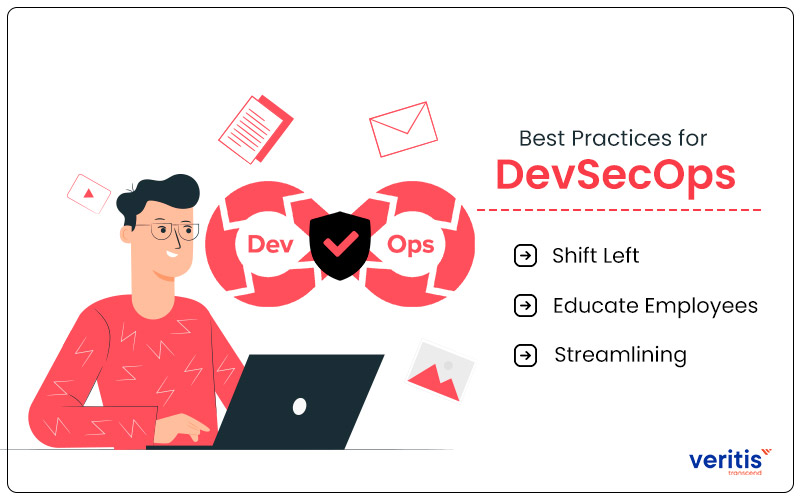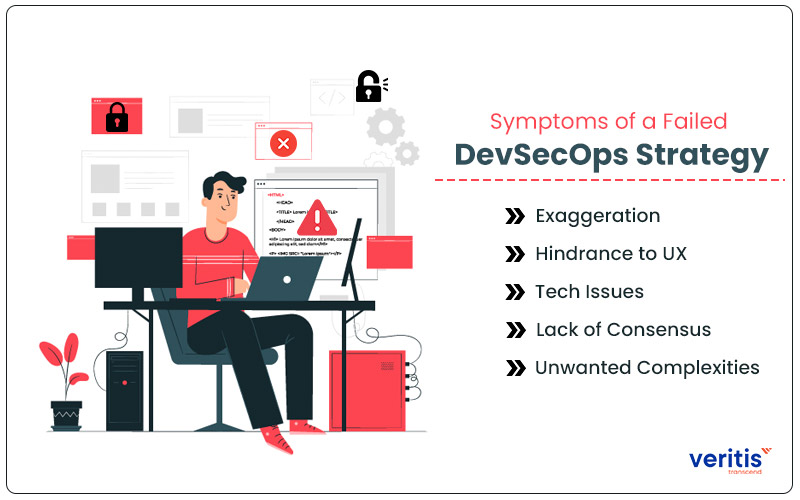
Table of contents
What is DevSecOps?
Security is one of the most significant aspects upon which companies concentrate much of their energies. These efforts are required as hacks, espionage, and malware continue to plague the world, and carefully developed solutions are dealt cruel blows due to these attacks. As development is threatened, companies have resorted to extreme security measures, hampering the development process. This was hardly the answer the companies were looking for, as productivity was not to be constricted in the name of protection. As people searched for answers, DevSecOps emerged as the solution.
But what is DevSecOps? We have heard of DevOps, where development and deployment are undertaken with the approach to optimizing the products for automation purposes. At the end of the product development, security is sowed into the product at the final stage. With DevSecOps, security is ingrained at every stage. Let’s understand what DevSecOps Services is.
Development, security, and operations, often known as DevSecOps, streamline security integration at each stage of the software development lifecycle (SDLC), from basic design through integration, testing, deployment, and software delivery.
The progression of how development organizations address DevSecOps represents security. Previously, a separate security team would “tack on” security to software at the end, and an independent quality assurance (QA) team would evaluate it.
This was workable when software updates were made available once or twice a year. However, the conventional approach, where the security is bolted, created an unacceptable bottleneck as software engineers adopted Agile and DevOps approaches, hoping to cut software development cycles to weeks or even days.
Agile and DevOps techniques and tools are easily integrated with the application and infrastructure security using DevSecOps. When security problems arise, they are more straightforward, quicker, and less expensive to fix (and before they are put into production). DevSecOps services also transform application and infrastructure security from being the primary duty of a security silo to being a shared responsibility of development, security, and IT operations teams. The DevSecOps process is successful because it automates the secure software supply without delaying the SDLC.
What is DevSecOps Methodology?
It is challenging for any firm to maintain short and frequent development cycles, incorporate security measures with little impact on operations, stay current with cutting-edge technologies like containers and microservices, and promote closer team cooperation. All these activities start on a human level, with the ins and outs of collaboration inside your company. Still, automation in a DevSecOps framework is the enabler of those human improvements.
But how should I automate specific tasks? The DevSecOps tools enable automation. Organizations should take into account the environment for development and operations. Examples include the continuous integration and deployment (CI/CD) pipeline or the DevSecOps pipeline, application programming interface (API) orchestration and release automation, management effectiveness, and tracking.
New DevSecOps security tools have contributed to advancing new security measures and enterprises adopting more agile development processes. However, cloud-native technologies such as containers and microservices are now a fundamental component of most DevOps programs, and DevOps security must adapt to meet them. In recent years, the IT landscape has transformed for more reasons than DevSecOps automation.
The DevSecOps process refers to integrating security throughout the entire app development process. This pipeline integration requires both new technologies and a new organizational attitude. DevOps teams should automate security to safeguard the overall environment, data, and continuous integration/continuous delivery process—a goal that probably includes the security of microservices in containers.
Useful link: 14 Statistics That Shed Light Upon DevSecOps’ Opportunities and Challenges!
What are the Best Practices for DevSecOps?

There are various best practices for DevSecOps. But first, let’s look at the standard practices.
Shift Left
Shift left is a motto used in DevSecOps: Software engineers are encouraged to relocate security from the DevOps (delivery) process’s right (end) to its left (beginning). Security is an essential component of the development process from the outset in a DevSecOps setting. DevSecOps-enabled organizations integrate their cybersecurity architects and engineers into the development team. Their responsibility is to ensure that the stack’s components are patched, set up securely, and documented.
Shifting left lets the DevSecOps team quickly identify security issues and exposures and ensure they are immediately addressed. The development team considers not only how to design the product effectively but also security.
Educate Employees
Engineering and compliance work together to create security. Organizations should create an alliance between the development engineers, operations teams, and compliance teams to ensure that everyone in the organization is aware of the company’s security posture and adheres to the same standards.
Everyone in the delivery process must know the fundamentals of application security, application security testing, and other security engineering techniques. Developers must also be familiar with thread models, compliance checks, risk assessment, exposure analysis, and security control implementation.
Streamlining
Good leadership fosters a positive culture that encourages change inside the organization. The obligation to provide information on process security and product ownership is crucial to DevSecOps. Then, developers and engineers may take ownership of the process and be accountable for their efforts.
DevSecOps operations teams should design a system that meets the mission objectives by utilizing the technologies and protocols that are best for their team and the current project.
The team becomes an active participant in the project’s success by being given the freedom to design the workflow environment that best suits their needs.
Useful link: What are the best DevSecOps practices for security and balance agility?
What are the Advantages of DevSecOps?

Using this technique can ensure a somewhat steady application that is less susceptible to malicious assaults. That is just one of the benefits of DevSecOps. Security and speed are the two main advantages of this idea. DevSecOps as a service also offers a wide range of capabilities advantageous to companies of all sizes.
Improvised Communications
This DevSecOps solutions culture encourages cooperation and coordination among IT workers with various abilities and capabilities to achieve a single objective. Bringing teams together is one of the main objectives of DevSecOps services and solutions.
Accelerated Development
A team can develop better as security changes are made at every crucial stage. This approach doesn’t require the developers to strain themselves to make the product invulnerable after everything is ready.
Robustness Assured
Although the DevOps team can perceive the security team as a source of delays, this shouldn’t be the case. Issues are found and fixed immediately before the entire project is finished. Ultimately, this tactic results in quicker projects and better quality control methods.
Timely Eradication of Flaws
A stitch in time saves nine. That’s DevSecOps’s approach to security, as the project members face flaws much more efficiently than ever before. Moreover, as the focus is not only on automation but also on security, the result will be much more resilient.
Useful link: Pros and Cons of DevSecOps
What are the Disadvantages of DevSecOps?

As is with everything, there are always disadvantages. So let’s look at the drawbacks of DevSecOps.
Overlooking Sensitive Data
The accelerated development speeds would also mean the project members might overlook some sensitive product areas. As a result, these areas would become potential inlets for security attacks.
Lack of documentation
Identification of exposures, especially those involving business logic, is made more difficult by the lack of documentation during the early stages of application development because it takes longer for security specialists to comprehend the logic of the program.
Seamless Communication is a Must
The two crucial actions from the IT department are cooperation and communication; for software development and security to function. However, it might not function properly if any of these teams hide important information from one another.
Useful link: DevSecOps – A DevOps Savior to ‘Cybersecurity’ Challenge!
What are the Symptoms of a Failed DevSecOps Strategy?

Even though most businesses have adopted DevSecOps services, there is a great danger of failure if other businesses rush to participate in the newest trend without the necessary knowledge. This strategy will reduce productivity and result in unnecessary costs, which could affect the entire firm. Let’s look at the signs of an ailing strategy.
Exaggeration
Organizations frequently enjoy exaggerating their advantages. For example, while security is ingrained in every firm on some level, some seek to overstate the situation by highlighting a few insignificant security features. Although this exaggeration has many different motivations, doing so would just illiterate everyone in the firm.
If management plastered DevSecOps all over its marketing materials and the employees had no idea what the nonsense was, there would probably be a conflict between the management and production teams. The situation will only worsen if the company accepts any DevSecOps projects, with the production team unsure how to proceed.
Hindrance to UX
The goal of DevSecOps is to simplify everyone’s lives. However, if the strategy is wrong, all three will suffer because the end user will have a bad experience. To improve the experience, the developers must develop new strategies, and testers will work out the flaws. Clients and users will only have to wait due to the delayed launch.
Tech Issues
The DevSecOps project entails both cultural and technical transformation. The business shouldn’t leave any glaring gaps after making the proper assessment. Data breaches and thefts will occur if this element is ignored. One should take the time to evaluate the organization’s readiness for a DevSecOps culture rather than rushing through the DevSecOps implementation plan.
Lack of Consensus
Management must consider the opinions of the production crew. If there is disagreement, meetings and discussions will stop, leading to opposing viewpoints with no solution. If one side chooses to be aggressive, it will lead to additional disputes. It is crucial to persuade one another of the plan’s advantages and disadvantages. This will reduce the likelihood of a DevSecOps failure.
Unwanted Complexities
Solutions’ goal is to simplify life, but if customers are obliged to run pillar to post, the goal is defeated. Both the user and production experiences must be straightforward and secure. The ultimate objective is to decrease the time to market and raise reliability across the board. There is little to no question that the DevSecOps strategy has failed if the development process is extremely complex.
Explore DevSecOps Consultancy Services
Conclusion of DevSecOps Services
A new approach called DevSecOps integrates security into the early phases of software development. It ensures complete operation, lessens cyber dangers and facilitates quick software product launches. By implementing security at every level of the SDLC, software solutions can be produced quickly. These security solutions can be used by those who work in the automobile, healthcare, financial, or retail sectors.
It is a management strategy incorporating a continuous delivery cycle with security, operations, application development, and IaaS. DevSecOps Services aims to integrate security into all phases of the SDLC. Security at every level of the SDLC makes continuous integration, cost-effective compliance, and speedy software delivery possible. Its fundamental goal is to make everyone responsible for security.
For more than ten years, Veritis, the Stevie Awards winner, has been a dependable partner for businesses of all sizes, including those on the Fortune 500. We have considerable experience integrating cutting-edge technology in a fluid environment and providing solutions for IT projects. Veritis provides a range of technological services for your company at a cost-effective solution. Contact us to embrace productivity with the most excellent DevSecOps tools.
Additional Resources: